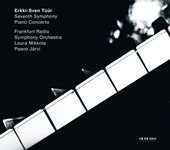|
Back
05/13/2014
Erkki-Sven Tüür: Piano Concerto – Symphony No. 7, "Pietas"
Laura Mikkola (piano), Frankfurt Radio Symphony Orchestra, NDR Choir, Paavo Järvi (conductor)
Recording: Alte Oper, Frankfurt (June 2009), hr-Sendesaal, Frankfurt (June 2010) – 62'41
ECM New Series 2341 – Booklet in English

   
Erkki-Sven Tüür weaves engaging sonic landscapes from the simplest, most familiar musical materials. Simple scalar figures and weaving gestures are dressed up in tintinnabulary orchestration, and harmonies often use familiar chords. What Tüür does is combine and layer these recognizable parts in surprising new ways. His training as a percussionist and background as a rock musician imbue his works with rhythmic vitality that is never straight-laced. There is a penchant to lapse into rock or jazz-derived passages, some of which seem to connect with their surroundings and some of which seem directly in conflict.
The works on this recording, an abstract concerto and a programmatic symphony, were both written in the first decade of this century for the Frankfurt Radio Symphony Orchestra. Each begins with a percussed unison, from which an opening Klang organically grows. This leads to the first choral entry in the Seventh Symphony.Here, the voices emerge almost as an instrumental family instead of familiar vocal sonorities. The text for the symphony is diverse, consisting of aphoristic, pacific utterances from sources as diverse as Mahatma Gandhi, Jimi Hendrix, and St. Augustine, all sung in English. A three-line refrain from Siddhartha Gautama gives the work a clear audible structure. Much of the choral writing is homophonic and is divided by motivically busy but harmonically static orchestral episodes. The orchestral writing holds the attention more readily than the choral moments, perhaps because of its more diverse gestural vocabulary, but the vocal portions are beautifully sung, effectively conveying the elegance and simplicity of the texts.
The Piano Concerto is a more tempestuous work. The three connected movements grow out of a gong-like low C, and influences from the electronic studio and spectralist school are omnipresent. The work seems to grow and blossom until the climactic transition into the third movement, heralding an unexpected jazzy episode. This jarring stylistic juxtaposition
re-accumulates into an ever more extroverted climax, followed by a peaceful, almost Impressionistic denouement.
In both works, Paavo Järvi leads the Frankfurt musicians expertly. Rhythms are precise and ECM's excellent recorded sound allows every detail of Tüür's imaginative orchestration to sparkle. The NDR Choir sings with excellent blend and diction in the Symphony, and pianist Laura Mikkola plays with panache in the Piano Concerto. Throughout, it is clear that these musicians are excellent Tüür evangelists , and devotees of this composer need not hesitate to heed their call. Newcomers may find Tüür’s shorter works a better starting point, but all listeners will find this recording engaging.
Marcus Karl Maroney
|